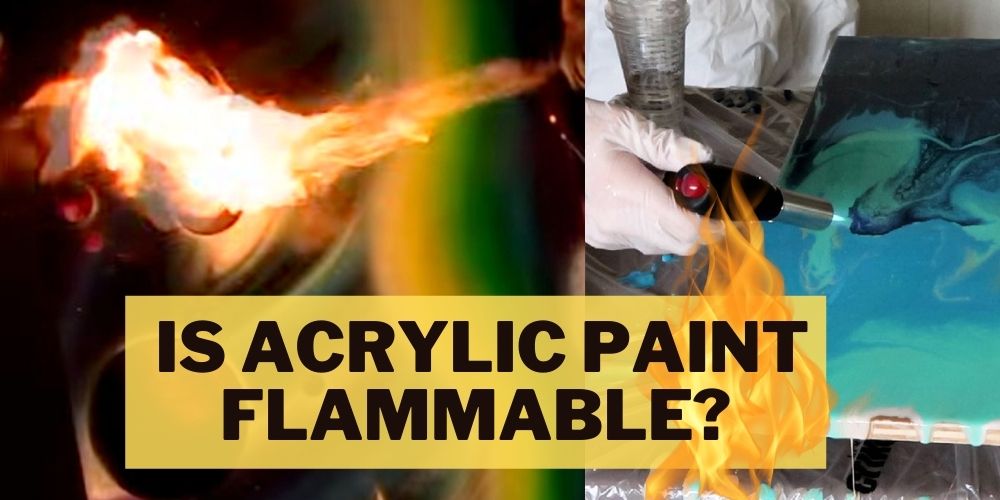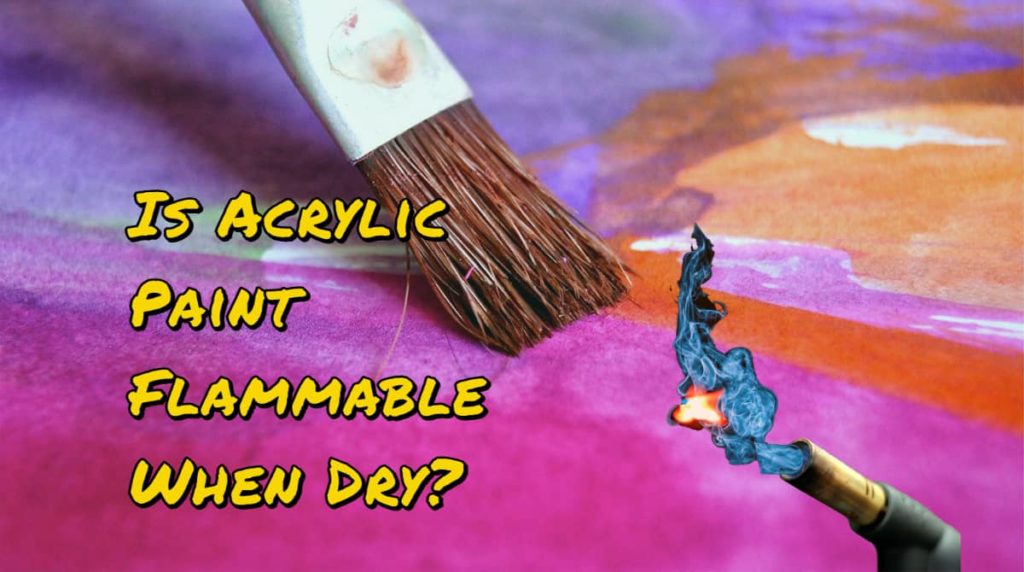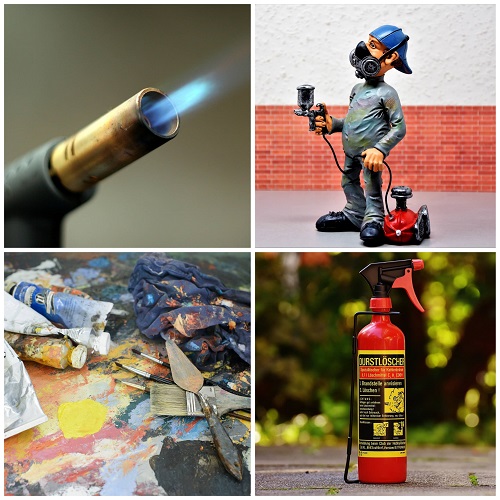Nowadays every individual is using some sort of paints in their school project or DIY renovations in their life. So if you are a professional artist you know about different types of paints like oil base, water-based.
But if you are a beginner you should know that the paints are made using different pigments, binders, and other chemicals which might be toxic. They might be flammable or combustible. But is acrylic paint flammable?

No, water-based acrylic paints are not flammable. They are just combustible. However, there are oil or solvent based acrylic paints as well. Oil based acrylic paints are flammable only in liquid state, but not in dry state. For your information, both the types are combustible in dry state.
Depending on the nature of the paint, it may or may not be combustible. Water-based paints are typically non-flammable, however, oil-based paints may be combustible due to the solvents used in their production.
Is Acrylic Paint Flammable?
No, it’s not.
Acrylic paint is primarily water-based paint since it utilizes water as a solvent and binders such as acrylic resins and acrylic polymer emulsion. When wet, it is non-flammable, but as it dries, the water particle evaporates, and its properties alter. As a result, it becomes combustible.
Lacquers and enamels made using solvent-based acrylics are extremely combustible. Acrylic latex paint, when dried, has become a plastic polymer that can burn at extremely high temperatures. So, you must keep it far from open flames.
What is Flashpoint?
When provided a source of ignition, a flammable material’s flashpoint is the lowest temperature at what point it can ignite.
Paper, gas, and dried wood are all examples of combustion products. At normal operating temperatures, these materials can ignite and burn. They have a lower flashpoint than most other materials.
On the other hand, combustible products have a high flash point and can only burn at high temperatures. Coal, metal foils, and plastics are all examples of flammable materials. Although acrylic paint is combustible, it is not flammable.
Now a question might be boggling in your mind: What is the Flashpoint temperature for a general flammable paint.
The answer is for an oil-based paint the temperature should be 141-199-degree Fahrenheit.
Acrylics are organic compounds with an acryloyl group produced from acrylic acid. Acrylic acid has a flashpoint of 124 degree Fahrenheit (51.11 degree Celsius) and a lower combustion temperature of 820 degree Fahrenheit (437.78 °C), making it flammable.
Flammable vs Combustible What’s the Difference?
You should know what combustible and flammable mean, as well as if the paint you’re working with is combustible, flammable, or both.
It’s important to realize that these two things are not the same; the only thing that distinguishes them is the flashpoint. A flammable paint’s flashpoint is 100 degrees Fahrenheit (37.8 degrees Celsius), while combustible paint’s flashpoint is between 100 and 200 degrees Fahrenheit (37,8 to 93,3 degrees Celsius).
Examples of some flammable materials are paper, some types of paints, gas, and so on. Some combustible materials are aluminum, coal, and some types of paints.

Is Acrylic Paint Flammable When Dry
It mainly depends upon the type of the acrylic paint, whether it is water based or solvent based.
Majority of the acrylic paint are water based. Water-based acrylic paint, is environment-friendly. The main component water makes it non-flammable in its liquid state. In dry stage also acrylic paint is only combustible but not flammable.
Normally flammable means which can set on fire faster but Combustible means which can burn above normal working temp.
In liquid stage it is not flammable but when dried it’s characteristics changes and structure wise it converts into a different kind of stuff which is mainly a solid plastic of hydrocarbon polymer. This plastic polymer is combustible in nature but not at all flammable.
If any flames are kept near this dried paint in open air(oxygen) it will easily burn above it’s ignition temperature which is generally very high.
When the acrylic paint is kept in its original container the paint is definitely flammable because the solvent exist in the paint.
But if you put it in wooden, clay canvas or any other kind of surface and let the paint to dry and cure for several hours the solvent of this paint will volatilized.
So it will become combustible but not flammable. It will burn at a very high temperature that is 560 degrees Fahrenheit

When acrylic paint dries properly, evaporation occurs, changing the properties of the paint. When dry, it produces a polymeric polymer that is combustible and may burn at extremely high temperatures.
Acrylic paint will burn at roughly 560 degrees Fahrenheit (293.3 degrees Celsius) once it has dried, which is the same temperature as acrylic resin.
Is Paint Thinner Flammable?
Yes, it is flammable.
According to OSHA (Occupational Safety and Health Association), paint thinner (mineral spirits) is a flammable liquid. It is classified as a flammable liquid since it can catch fire and has a flashpoint below 199.4 degrees Fahrenheit (93 degrees Celsius). Paint thinner has a flashpoint of approximately 104 degrees Fahrenheit.
Acrylic paint can be thinned with either water or acrylic medium. Water dissolves the acrylic binder, making the paint appear watercolor-like and allowing it to settle into the surface, resulting in a matte finish. Acrylic medium eliminates the need for water, allowing the paint to sit on top of the surface and maintain a rich, glossy finish. The amount of water you use is determined by the impact you want to achieve and the surface you’re working with.
Paint thinner, being a flammable liquid according to OSHA rules, can easily catch fire. Working with paint thinner near sources of ignition or smoke should be avoided at all costs.
Is Acrylic Latex Paint Flammable?
No. Acrylic Latex Paint is not Flammable.
The phrase “latex paint” is misleading because it does not include any rubber or latex. It is, nonetheless, a very popular paint because of its smooth and long-lasting finish, which can be used both indoors and outdoors. The latex paint is extremely easy to clean.
Acrylic latex paint has a synthetic latex binder and Titanium Dioxide as a pigment. Water serves as the solvent, making it a water-based paint that is non-flammable in both the liquid and dried stages.
Latex paint has flammability flashpoints of above 200 °F (93 °C), therefore there’s a slight chance it’ll catch fire. However, you’ll notice that some latex paint additives will burn, especially if the paint is employed as an aerosol. As a result, you must use caution.
Furthermore, the paint has fewer volatile organic components. Even yet, the vapors it emits are a minor concern. Ethylene glycol, which is commonly included in latex paints, can have modest effects on the body when inhaled.

Is acrylic Enamel Flammable?
Acrylic Enamel is not flammable, but it is combustible when dried.
Acrylic enamel is generally used to paint on car body, bikes, tires and different industrial machineries. The smooth, glossy and bright finish on the cars are due to of the application of this enamel paint.
The water based acrylic enamels are nonflammable when dried. Though it dried quickly from the outside but it takes long time even weeks to cure completely. Acrylic enamel not only has a high durability index. After drying up thoroughly its hard surface also makes it weatherproof. However, oil based acrylic paints are flammable in liquid stage and it will be combustible when dried.
According to NFPA guidelines acrylic enamel has a flammability rating of 1 and a flashpoint of 210 degrees Fahrenheit, per the Hazardous Materials Identification System (HMIS) (98.9 degrees Celsius).
Is Spray Paint Flammable?
Spray paint is easy to use and quite an affordable option. So, the question is does it catch fire easily? Spray paint is oil-based and contains gas propellants such as butane and propane, making it combustible when applied. The paint is pressured in the can, and when it is released, it is very poisonous and flammable. It becomes non-flammable after it has dried on the surface.
Are Acrylic Paint Fumes Flammable
Acrylic paint fumes might be combustible in some cases. Water-based acrylics normally do not emit any flammable fumes. Most of these items are flame-resistant. Some goods, however, may contain harmful compounds such as ammonia, formaldehyde, and mercury or silver metallic paints.
Safety Tips while using Butane torch on Artwork made with Acrylic
Many artists prefer using butane torch on their artwork during or after an acrylic pouring to make some wonderful effects.

Acrylic pour artists most commonly use butane torches to add heat to their paintings. These are often the first choice for acrylic pours due to their comparatively low cost and ease of refilling.
But when you work with any paint or thinner, you need to adhere to safety precautions. Whether it is flammable or not you need to use safety gear like gloves, protective glasses, mask while working. Always use the ventilated area as it can contain toxic fumes and cause nausea, breathing issues, and severe headaches.
You need to consider these safety tips while using a butane torch on acrylic pouring
Frequently Asked Questions (FAQs)
Get your questions answered here:
What happens when acrylic paint gets hot?
Acrylic paint dries to a semi-flexible plastic when exposed to air. Heat softens and influences it, but unlike most plastics, it does not melt or alter shape unless a greater amount of heat and/or pressure is applied. Excessive heat will cause the paint to dry out and become useless.
Can Acrylic Paint Be Put in the Oven?
If you’re painting a ceramic mug or plate and want to heat cure it, you’re probably wondering if acrylic paint can be baked.
The good news is this: Yes, acrylic paint may be baked in the oven. It will give you a breath-taking finish. It’s critical, though, that the material you’re painting is oven safe and won’t emit harmful compounds. Before baking, double-check the paint manufacturer’s specifications and the material manufacturer’s specifications.
Tip: Never bake paint in an oven that is used for preparing food. Because poisonous gases can escape from an oven, you should only use one that is specifically designed for work like this.
Conclusion
Don’t bother searching “is acrylic paint flammable?” any more. As now you should have clear idea on this topic.
Flammability is not an issue for most of the acrylic paint applications, whether it is used for painting or DIY renovation work. Sometimes it is used as radiator paint as well. but it catches fire when the temperature reaches above 560 degree Fahrenheit.
If you’re working with temperatures above 500 °F (260 °C), there are a few high-temperature paint options that are better suited to work.



